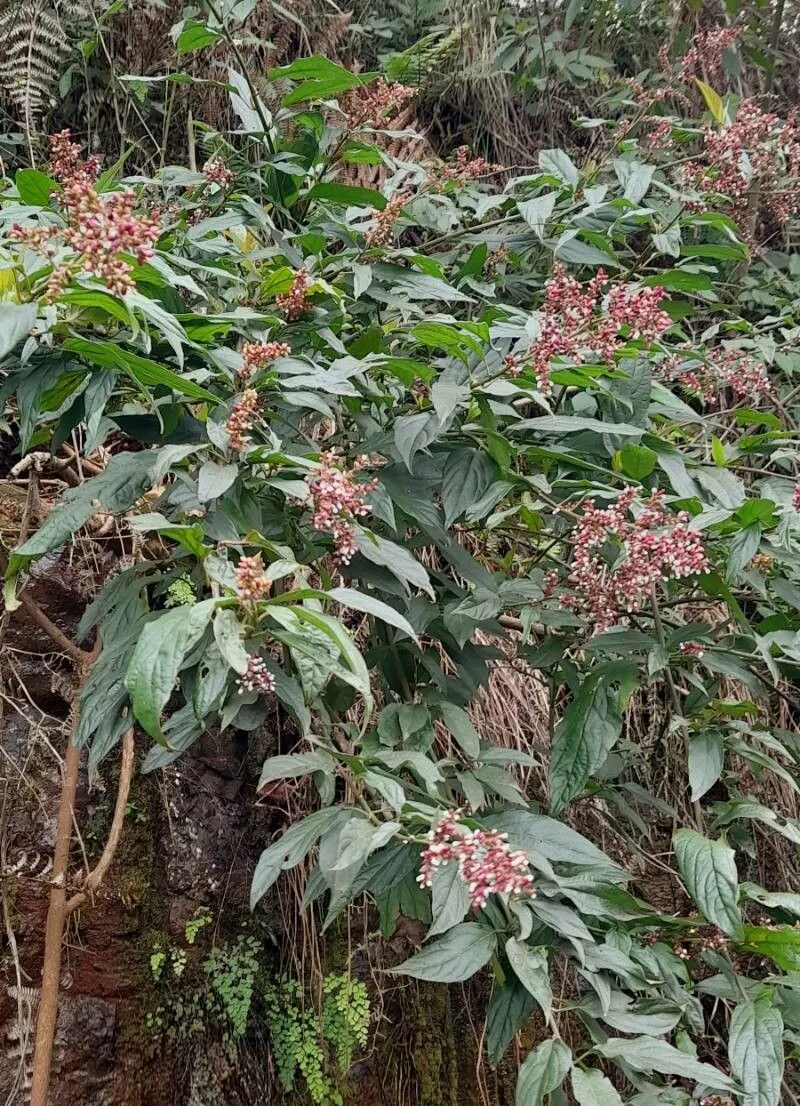
Author: (Jacq.) Kunth
Bibliography: F.W.H.von Humboldt, A.J.A.Bonpland & C.S.Kunth, Nov. Gen. Sp. 2: 197 (1818)
Year: 1818
Status: accepted
Rank: species
Genus: Chamissoa
Vegetable: False
Observations: Trop. & Subtrop. America
False chaff flower, scientifically known as Chamissoa altissima, is a notable member of the Amaranthaceae family. This plant species, first described in detail by F.W.H. von Humboldt, A.J.A. Bonpland, and C.S. Kunth in their groundbreaking work “Nova Genera et Species Plantarum” published in 1818, presents a fascinating study for botanists and plant enthusiasts alike.
Native to tropical and subtropical regions of America, Chamissoa altissima thrives in a variety of environmental conditions, making it a resilient and versatile species. It can often be found flourishing in wild, uncultivated areas, indicative of its robust nature. The plant’s adaptability to different climates and soils is a testament to its evolutionary success within its native range.
Characterized by its distinct appearance, the False chaff flower features elongated, slender stems that can grow to impressive heights, sometimes reaching upwards of several feet. The leaves of Chamissoa altissima are typically broad and ovate, creating a lush, green foliage that adds to the plant’s aesthetic appeal. During its blooming period, it produces small, inconspicuous flowers that are usually clustered together in dense inflorescences.
The naming and classification of this plant reveal a rich history of botanical exploration and discovery. The specific epithet “altissima” itself signifies the plant’s tall stature, while the taxonomy follows the authorities such as Joseph Jacquin and Karl Sigismund Kunth, who made significant contributions to its botanical documentation. The historical journey of its naming highlights the collaborative efforts in the scientific community to accurately categorize and understand plant species from diverse regions.
In addition to its botanical characteristics, Chamissoa altissima plays a role in its ecosystem. It can contribute to soil stabilization, acting as ground cover in some areas. However, its aggressive growth pattern sometimes leads to it being considered a weed in certain agricultural settings, necessitating management and control to prevent it from overtaking crops.
In conclusion, the False chaff flower (Chamissoa altissima) is an intriguing plant that not only displays unique botanical features but also carries with it a rich history of botanical research. Its ability to adapt and thrive in various environments underlines its ecological importance in tropical and subtropical America. Whether admired for its resilience or managed for its invasiveness, Chamissoa altissima remains a significant subject of study within the diverse family of Amaranthaceae.
Eng: false chaff flower
Por: mofungo-gigante
En: False chaff flower
Pt: Mofungo-gigante
© copyright of the Board of Trustees of the Royal Botanic Gardens, Kew.
© copyright of the Board of Trustees of the Royal Botanic Gardens, Kew.
© copyright of the Board of Trustees of the Royal Botanic Gardens, Kew.
Taken Jul 23, 2022 by Gonçalves da Cunha Lucas (cc-by-sa)
Taken Jun 1, 2022 by Rhamos Nancy (cc-by-sa)
Taken Jan 23, 2005 by Thiago Flores Flores (cc-by-sa)
Taken Jul 23, 2021 by Trap Hers (cc-by-sa)
Taken Jul 23, 2021 by Trap Hers (cc-by-sa)
Taken Jun 1, 2022 by Rhamos Nancy (cc-by-sa)
Taken Jul 23, 2022 by Gonçalves da Cunha Lucas (cc-by-sa)
Taken Jul 22, 2022 by Trap Hers (cc-by-sa)
Taken Jul 23, 2021 by Trap Hers (cc-by-sa)
Taken Dec 22, 2021 by Juan Carlos Ordonez (cc-by-sa)
Taken Apr 9, 2014 by Nelson Zamora Villalobos (cc-by-nc)
Taken Jul 22, 2022 by Trap Hers (cc-by-sa)
Taken Aug 21, 2008 by OTS – Oviedo-Brenes, Federico (cc-by-nc-sa)
Taken Jun 1, 2022 by Rhamos Nancy (cc-by-sa)
Taken Jul 22, 2022 by Trap Hers (cc-by-sa)
Taken Aug 21, 2008 by OTS – Oviedo-Brenes, Federico (cc-by-nc-sa)
Taken Apr 17, 2019 by OTS – O. Vargas (cc-by-nc-sa)
Taken Apr 17, 2019 by OTS – O. Vargas (cc-by-nc-sa)
Taken Apr 17, 2019 by OTS – O. Vargas (cc-by-nc-sa)
Taken Apr 17, 2019 by OTS – O. Vargas (cc-by-nc-sa)
Growth habit>: Vine, Forb/herb
Family: Myrtaceae Author: (F.Muell.) K.D.Hill & L.A.S.Johnson Bibliography: Telopea 6: 402 (1995) Year: 1995 Status:…
Family: Rubiaceae Author: Pierre ex A.Froehner Bibliography: Notizbl. Bot. Gart. Berlin-Dahlem 1: 237 (1897) Year:…
Family: Sapindaceae Author: Koidz. Bibliography: J. Coll. Sci. Imp. Univ. Tokyo 32(1): 38 (1911) Year:…
Family: Asteraceae Author: A.Gray Bibliography: Pacif. Railr. Rep.: 107 (1857) Year: 1857 Status: accepted Rank:…
Family: Fabaceae Author: Medik. Bibliography: Vorles. Churpfälz. Phys.-Ökon. Ges. 2: 398 (1787) Year: 1787 Status:…
Family: Aspleniaceae Author: (Cav.) Alston Bibliography: Bull. Misc. Inform. Kew 1932: 309 (1932) Year: 1932…